Hi all,
This week I am reflecting on Marina Abramović’s (b.1946) works as a way to confront some of the ambivalent frustration that I have been feeling lately. In doing so, I hope to reach a semblance of cathartic complexity that allows me to feel all the feelings without breaking down. In particular, I look at Abramovic ’s blinding and thought provoking performance pieces from the early 1970s and reflect on my own capacity for humaness beyond binaries of pain and joy, emptiness and salvation, sadness and happiness. You get the point. I also look at how in canonical performances like Lips of Thomas (1975) as well as her series of performances known as Rhythms (1973–74) illustrate profound moments of confrontation: confrontation with oneself and others humanity, and the limits of devotion and at times compassion that summon a brutal reality of a nihilistic world. In her works, Abramović pushes the limits of her humanity and that of her audience. For her, boundaries become transgressive and unintelligible as she transcends pain and glory, becoming to me one of the best to ever do it! Her work also makes clear to me that humans although capable of extraordinary cruelty, also hold capacity for more complex feelings and thoughts beyond basic brutality.
TW: This week’s substack is full of intense imagery so please feel free to skip and come back next time.
Your Sister Killjoy
Marina Abramović is perhaps the most famous performance artist, I feel and know that her fame and brilliance transcends the art world and brings with it misunderstandings of satanism and other such nonsense. Since the beginning of her career she has made it integral to interrogate the physical and mental limits of the human body as a means of emotional and spiritual transformation. In the Rhythm series and Lips of Thomas, Abramovic showcases a near inhuman level of endurance through extreme duration, pain, exhaustion, and danger in order to transcend her body and mind. Her work is ritualistic and devotional, recalling religious imagery. For example, in Lips of Thomas, Abramović self flagellates until she draws blood, implicating the imagery of self-flagellating monks of the thirteenth century whipping up blood in declaration of penance and self clarification. Similarly, in Lips of Thomas, Abramović carved into her belly a pentacle—one of the reasons her work is often related to satanism—drawing comparisons to witchcraft. Her ritualistic acts not only showcase Abramović’s devotion to her work but also shows the risks she is willing to take as a means of demonstrating human strength of character and endurance. The Rhythm series for me showcases the cyclic nature of cruelty, especially as memory serves to open up old wounds and form new ones gushing with ferocity. However the series also demonstrates the multidimensional nature, not only of human endurance but also the somewhat extensive flow of “the milk of human kindness.”
Rhythm Series
In Rhythm 10 (1973), Abramović plunged a knife between her outspread fingers of one hand, stopping only after she had cut herself 20 times. Having made an audio recording of the action, she then played back the sound while repeating the movements—this time trying to coordinate the new gashes with the old wounds. According to Abramović, Rhythm 10 was based on a drinking game played by Russian and Yugoslav peasants where you spread your fingers out on a wooden bar or table and stab down a sharp knife, fast, in the spaces between your fingers. Every time the player missed and cut themselves, they would have to take another drink. The drunker you get, the more likely you are to stab yourself. Much like Russian roulette, “it is a game of bravery and foolishness and despair and darkness – the perfect Slavic game.” When I first saw a video recording of Rhythm 10 it was in the darkness of a classroom. I remember I couldn’t stand the sight of her plunging each knife. I flinched every time a cut was made, holding my breath—knowing she doesn’t die from a stab wound to the hand—I couldn’t stand the white noise of the gallery, the rhythms of the knives thumping along it’s sonic waves. Quite literally, Rhythm 10 took my breath away. It positioned me in a void of my own making where I felt and still feel the danger and excitement of drawing blood through the malice of speed and repetition. In the end Abramović walks away leaving the blood stained sheet of white paper and scattered knives behind. As a viewer I knew something brave had taken place. As a feeling, I wonder if it’s stupid to reopen old wounds and call to them in blood.
In Rhythm 5 (1974), Abramović laid down inside the blazing frame of a wooden star fashioned after the Communist star. Slowly, as the fire burned, her oxygen supply depleted, she lost consciousness and had to be rescued by concerned onlookers. Before she laid down, Abramović cleansed herself by cutting her nails, toenails, and hair, casting them into the burning star. According to her, by burning the communist five-pointed star, she was mentally and physically purifying herself of her past—Abramović was born in Belgrade, Serbia, then part of communist Yugoslavia. The burning of the star also reflected her confronting her personal past whilst also addressing the political traditions that defined her. To me, Rhythm 5 represents the self-sacrificing reality of Abramović’s art and calls to my mind the need for self-sacrificing in order to make for a better hellscape. I don’t want to get cheesy, but it really warmed my heart to know that people were paying close enough attention and were truly invested in the work to notice when the artist was no longer consciously present. However, the decency of humanity is, for me, limited and at times opportunistic. Dark, I know, but the actions taken by the audience in Rhythm 0 proves me right. Maybe, I’m being too harsh in my despair, but I’m pulling at my various experiences. Sure, people can be kind, but the other side of that coin is plain vileness.
In Rhythm 0 (1974), the most famous in the series, Abramović invited audience members to do whatever they wanted to her using any of the 72 items she provided: pen, scissors, chains, axe, loaded pistol, and others—the performance ceased when audience members grew too aggressive. Rhythm 0 reminds me of Yoko Ono’s Cut Piece (1964). Much like Abramović’s Rhythm 0, in Cut Piece, audience members were invited to approach the artist, in this case to cut away a piece of clothing as she knelt silently on stage. However, unlike Rhythm 0 the initially hesitant audience members were gentle and did not grow aggressive. I think it’s because they where given clear directions to cut the clothes rather than do whatever they wanted as Abramović insisted. Now I could get into it about free will and other such lunacy and how given the opportunity to do whatever we want we choose to do naughty things. But when held to a standard we work to meet that standard. One case breeds gentility and the other violence. Again, two sides of the same coin. Both Abramović’s Rhythm 0 and Ono’s Cut Piece, proves the complexity of humans, although I don’t think it should be complex to be a decent person, I sometimes, as a fuck you to social mores may engage in some cheeky misbehaviour, though not to the point of violence.
In an image of Rhythm 0, which I have included here, Abramović looks despondent, her cheeks seemingly wet with tears. On her chest is a sign that says “VILE,” in all capital letters, she holds a rose. In the six-hours that it took for her to stand there and receive mostly abuse instead of sympathy from her fellow human beings, I look at her and wonder if the audience saw her as a sounding board on which to project their madness and self-hatred. I wonder if the person that stuck “VILE” on her chest felt they were vile and unworthy. But the person I think of the most is the one that handed her the rose. I wonder if the rose had thorns and that at act, which at first glance seems courageous and kind in the face of cruelty is just a softer brutality, a weaker kindness, diluted and yellow-bellied. In describing the piece, Abramović recalls: “It was six hours of real horror. They would cut my clothes. They will cut me with a knife, close to my neck, and drink my blood, and then put the plaster over the wound. They will, carry me around, half-naked, put me on the table, and stuck the knife between my legs into the wood.” Silence, is what I think of when she says this, I wonder, and in fact maybe I know, that because Abramović’s body was passive and female it made it easier for the audience, especially the male audience members to cut her open, mistreat her, and call her vile.
Lips Of Thomas
I conclude this post with Abramović’s 1975 performance, Lips of Thomas. After my doom and gloom pitch, I want to end on a note of clarity. Lips of Thomas, for me is about self-forgiveness and forgiveness of others, it’s about bearing witness to repentance and self-reflection. According to Abramović, while she did not realize it at the time of performance, she later noticed that Lips of Thomas is actually autobiographical. She says: “Lips of Thomas was the most complicated piece at the time that I made, and looking backwards I see this is very autobiographical, because there's so many elements in this piece that really deals with my biography and Communist background and then also the Orthodox background of my family. It was everything kind of mixed there the cross, the Communist star cut on my stomach, the symbols of the honey and the wine.” I like to think that after the gut wrenching moments in the Rhythm series Abramović underwent many transformations and that Lips of Thomas was her moment of clarity with herself. For me, watching her carve the star on her stomach and flagellate herself to exhaustion has been transformational. I often think about Abramović’s works, especially the works I discussed here. I think of her extreme endurance and her daring bravery. On days like these when the world is falling into pieces and few condemn genocide, I think of Abramović who to me stands as a reflection of us all, complex and indignant.

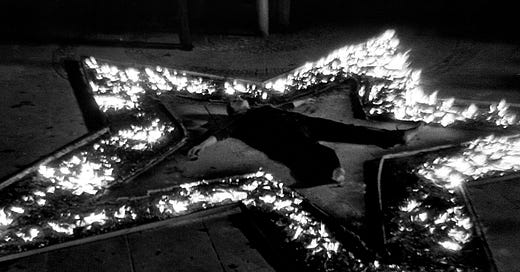


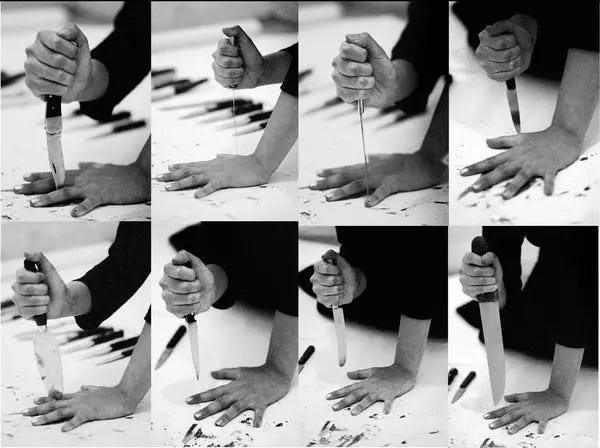
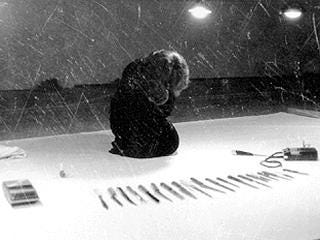

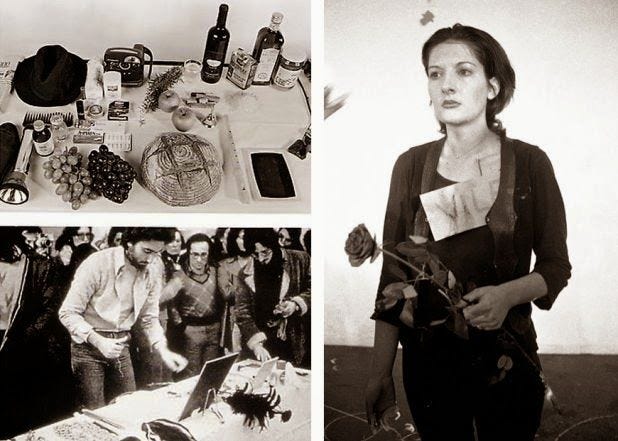
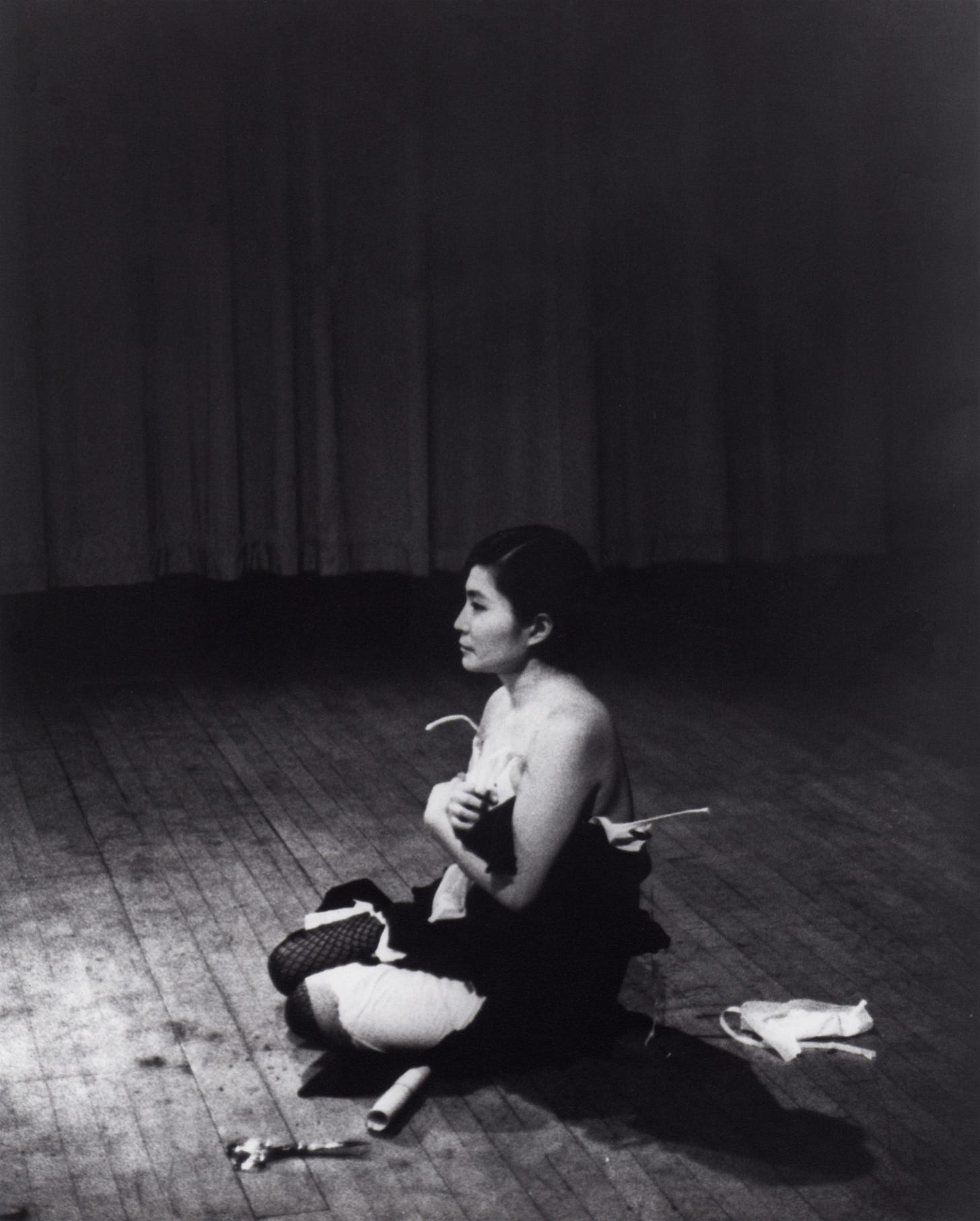
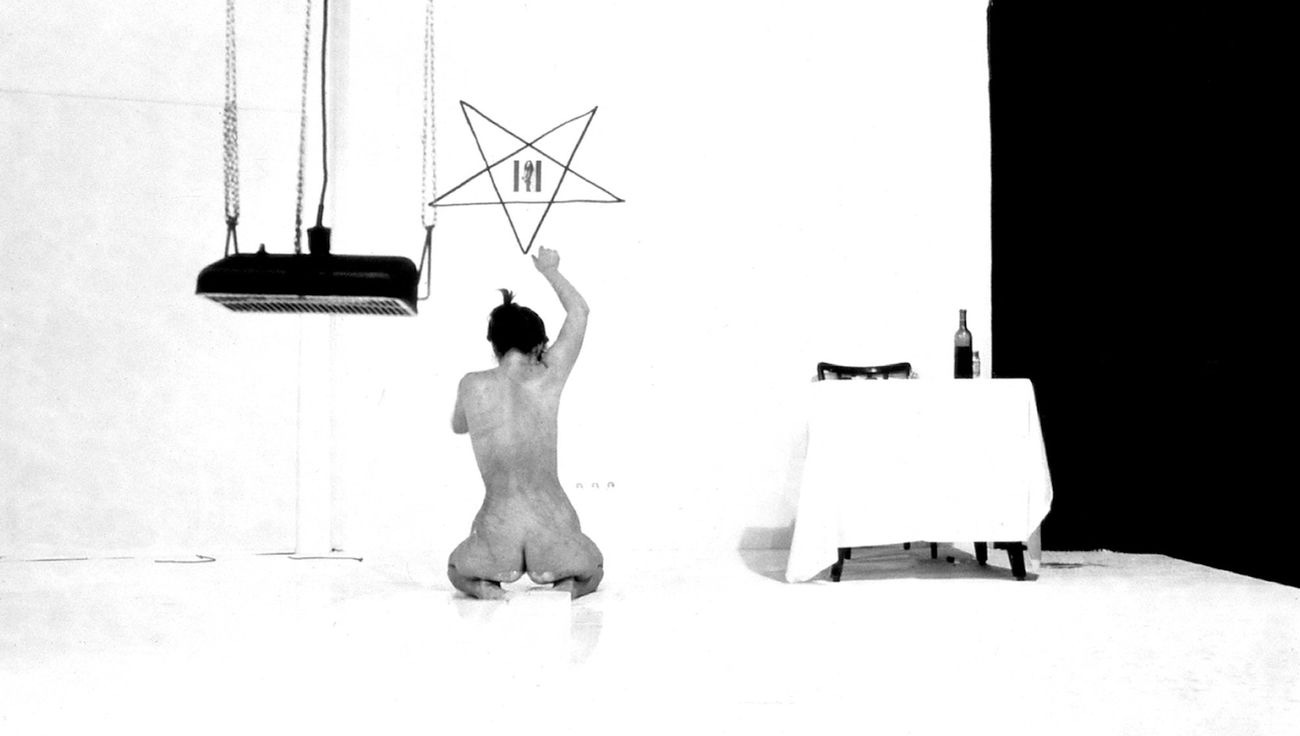
I was gagging at the descriptions of Rhythm 20 but you wrapped it up well!